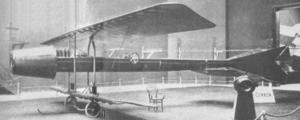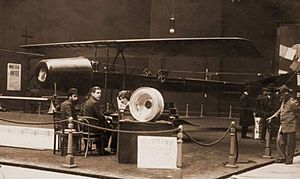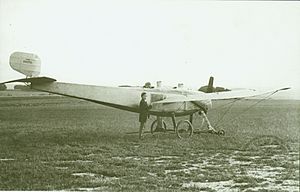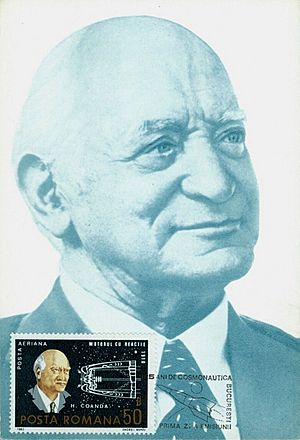Henri Coandă facts for kids
Quick facts for kids
Henri Coandă
|
|
|---|---|
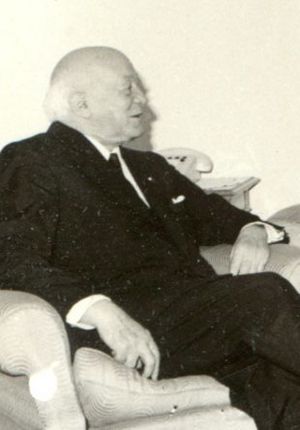
Henri Coandă at a meeting with Nicolae Ceaușescu in 1967
|
|
| Born |
Henri Marie Coandă
7 June 1886 |
| Died | 25 November 1972 (aged 86) Bucharest, Socialist Republic of Romania
|
| Nationality | Romanian |
| Alma mater | Technical University of Berlin Montefiore Institute |
| Occupation | Engineer, physicist, inventor |
| Known for | Coandă effect, aeronautical engineering |
| Parent(s) | Constantin Coandă (father) Aida Danet (mother) |
Henri Marie Coandă (born June 7, 1886 – died November 25, 1972) was a famous Romanian inventor, engineer, and pioneer in aerodynamics. He is known for building an experimental aircraft called the Coandă-1910. Some people believe this was the world's first jet plane, though this is a debated topic. Coandă also invented many other things, designed a "flying saucer," and discovered the Coandă effect, which is about how fluids (like air or water) move.
Contents
Henri Coandă's Life Story
Early Years and Education
Henri Coandă was born in Bucharest, Romania. He was one of many children in his family. His father, General Constantin Coandă, was a mathematics professor. Henri's mother, Aida Danet, came from France. From a young age, Henri was fascinated by the power of wind.
He went to elementary school in Bucharest. Later, he attended high school at Liceu Sf. Sava. After three years, his father wanted him to have a military career. So, Henri transferred to the Military High School in Iaşi. He finished high school in 1903 as a sergeant major. He then continued his studies at the School of Artillery, Military, and Naval Engineering in Bucharest. In 1904, he went to Germany and studied at the Technische Hochschule in Berlin.
Henri Coandă became an artillery officer. However, he was much more interested in the technical challenges of flight. In 1905, he even built a missile-aeroplane for the Romanian Army. He continued his studies in Belgium, where he met another aviation pioneer, Gianni Caproni. In 1908, Coandă returned to Romania to serve in the army. But his passion for inventing didn't fit well with military life. He left the army and traveled widely, even visiting Tibet.
Aviation Work in France
In 1909, Coandă moved to Paris, France. He joined a new school for aeronautical engineers, which is now called SUPAERO. He graduated in 1910 as one of the top students in the first class of aeronautical engineers.
In 1910, Henri Coandă designed and built an aircraft called the Coandă-1910. He showed it to the public at an aviation show in Paris. This aircraft was special because it used a new type of engine. Instead of a propeller, it had a rotary compressor. This engine was meant to pull air in from the front and push it out the back.
There is some debate about whether the Coandă-1910 actually flew. Some people at the time said it could not fly. Years later, after jet technology became common, Coandă claimed his plane was a "motorjet" and that it did fly. Some aviation experts support his claim, while others disagree.
From 1911 to 1914, Coandă worked in the United Kingdom for the Bristol Aeroplane Company. He designed several planes there, known as the Bristol-Coanda Monoplanes. One of his designs won an award in a military airplane competition in 1912.
In 1915, he went back to France. During World War I, he designed new propeller airplanes. One of these, the Coandă-1916, had two propellers near the tail. This design was later used in the 1950s for the Sud Aviation Caravelle transport plane, where Coandă worked as a consultant.
Between the two World Wars, Coandă continued to travel and invent. In 1934, he received a French patent for something related to the Coandă Effect. In the early 1930s, he used this same idea to design a disc-shaped aircraft. He called it Aerodina Lenticulară, which means "lens-shaped aerodyne." This "flying saucer" was designed to use high-pressure gases to move through a special vent system. He applied for a patent in 1936, but a full-sized version was never built.
World War II and Later Work
During World War II, Coandă stayed in France. He worked on developing a propulsion system for snow sleds, based on his 1910 engine design. This project lasted about a year but did not lead to production.
After the war, Coandă's research on the Coandă Effect became very important. This effect shows how a small stream of fast-moving fluid can create a larger flow of slower fluid. While it wasn't successful for aircraft engines, this effect is now used in many smaller devices. For example, it's used in packaging machines and even in the Dyson Air Multiplier bladeless fan.
In 1969, Henri Coandă returned to his home country of Romania. He became the director of the Institute for Scientific and Technical Creation. In 1971, he helped reorganize the Department of Aeronautical Engineering at the Polytechnic University of Bucharest. Henri Coandă passed away in Bucharest on November 25, 1972, at the age of 86. He is buried in Bellu cemetery.
Awards and Recognitions
Henri Coandă received many honors and awards for his work:
- In 1965, he received the Harry Diamond Laboratories Award at a symposium in New York.
- He was made an Honorary Fellow of the Royal Aeronautical Society in 1971.
- Bucharest's main airport, Henri Coandă International Airport, is named after him.
- He received the "Vielles Tiges" Award and Grand Gold Medal.
- He was given a UNESCO Award for Scientific Research.
- He also received the Medal of French Aeronautics, the Order of Merit, and the Commander ring.
Key Inventions and Discoveries
- The Coandă-1910 (1910): An experimental aircraft that used a ducted fan for propulsion.
- Twin-Engine Aircraft (1911): He designed a plane with two engines driving a single propeller. This setup helped cancel out the twisting force (torque) from the engines.
- Beton-bois: A new decorative material for building. A famous example of its use is the Palace of Culture in Iaşi, Romania.
- Underground Liquid Detector (1926): While working in Romania, Coandă created a device to find liquids underground, which was helpful for finding oil. He later designed a system for offshore oil drilling in the Persian Gulf.
- The Coandă Effect: This is his most famous discovery. After studying it for over 20 years, Coandă described this phenomenon. It explains how a fluid jet tends to stay attached to a curved surface. This effect has been used in many aviation inventions and other technologies.
- Solar Desalination System: He developed a modular system to turn seawater into fresh water using solar energy. This was a clean and environmentally friendly idea.
See also
 In Spanish: Henri Coandă para niños
In Spanish: Henri Coandă para niños
- History of aviation
- Early flying machines
- List of firsts in aviation
- List of aviation pioneers


